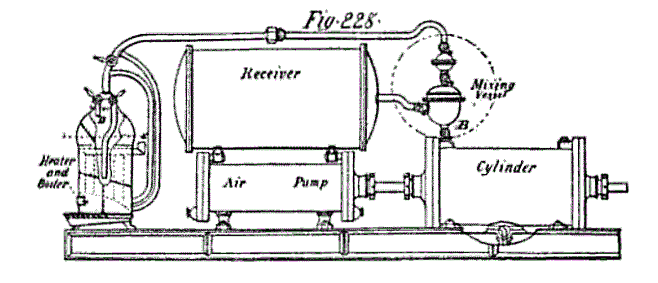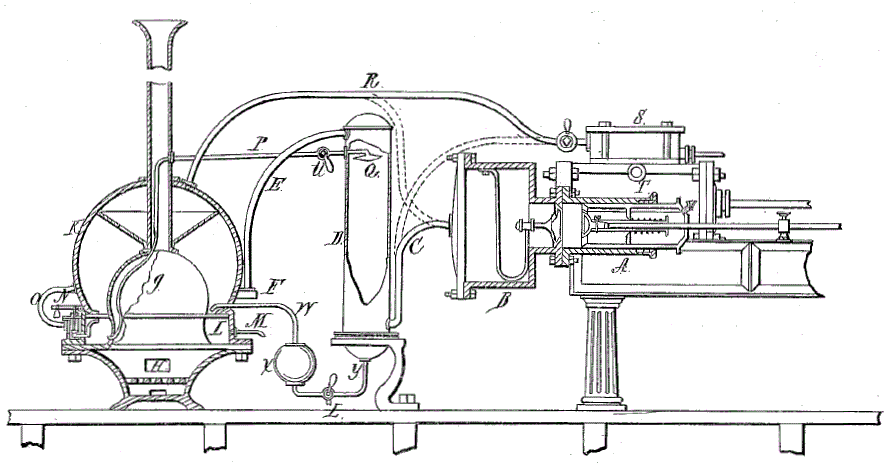Gallery opened 18 Mar 2023
Updated 20 Mar 2023
Patent & more info added




The Cloud Engine |
Gallery opened 18 Mar 2023 |
THE CLOUD ENGINE
I first encountered the Cloud Engine when reading through the Transactions of the American Society of Mechanical Engineers (1886, Volume 7, p690) and was immediately intrigued. I quote:
"More than thirty years ago, considerable interest was excited by the fabulous saving reported to have been made by the "Cloud Engine" of William Mount Storms. This saving was certified to over the signature of Horatio Allen, who reported that by careful trials with an engine in practical use, he found a saving of over 50%... THe trial on which this conclusion rested was made with an engine 8 inches diameter of piston and 12 inches stroke. It was run for a short time with steam of 70 lbs pressure cut off at 2 inches. The engine was then changed so that the piston drew in 1.5 inches of atmospheric air before the steam-port opened, after which 2 inches of steam was admitted, to mingle with the air. The load was obtained by a brake; the comsumption of steam was assumed to be the same, the saving being indicated by the increased number of revolutions. The idea of the inventor was that there was a production of "viscular vapour" (whatever that might be, unknown to Google) within the cylinder. |
 | Left: The Cloud Engine: 1886
|
'More than thirty years ago' leads us to The Practical Mechanic's Journal Volume 7, 1854, p175. This reported that Mr William Mount Storms had formed a stock company to exploit what was even then called 'the Cloud Engine':
"Mr Storms' invention relates to what he terms a 'the Cloud Engine' and consists of mixing atmospheric air with the steam during its expansion in the cylinder. His theory assumes that the effect of mixing cold air with steam, is to considerably increase the volume, the steam being slightly condensed but the air expanded in a much greater degree. A long series of careful experiments was carried out at the Novelty Iron Works, and the results, although discordant, were in the mass extrenely favourable to the new system. The engine employed for the experiments was a high-pressure horizontal engine, a double-acting pump being fixed at it side for compressing and injecting the air. When a pump is made to compress gas, it first compresses and then delivers it, the early portion of the stroke being performed without generating a sufficient pressure to raise the delivery valve. The engine was so arranged that the steam was admitted at the usual time, at or a trifle before, the commencement of the stroke, and allowed to follow through about two-sevenths of the stroke. At this point it was cut off and commenced expanding, and at or about the same instant the pump, which had previously compressed its contents to about the required tension, commenced injecting air into the cylinder. The inventor believes that this air assists in maintaining the working pressure to a far greater extent than that to which the compressing pump retards the motion of the engine.""Mr Horatio Allen, of the firm of Stillman & Allen, proprietors of these extensive works, a throroughly scientific and practical engineer, superintended many of the experiments, and made several reports to the parties more immediately interested. The last is dated August 1st, and contains a brief summary of the results, steam alone first being used, and then steam and air together, the resistance (which was produced by a friction brake) being constant in all the experiments." Here is a paragraph stating that steam alone gave 107 engine revolutions for one pound of coal, while the cloud system gave 190 revolutions per pound. An impressive advantage if true. "It will be seen that the performance with steam alone is under as favourable circumstances as can be provided in a high-pressure engine. The expansive principle is fully carried out, and nothing is wanting to make the performance by steam alone a fair standard with which to compare that of the cloud engine, and this performance has been largely exceeded by the latter. What the proportion of saving is to be, remains to be determined by more extensive use." |
 | Left: The Cloud Engine: 1853
"IMPROVED PROCESS FOR MIXING AIR AND STEAM FOR ACTUATING ENGINES" |
A: Air compressor | P: Conveys heater water to charger D |
The patent text refers to "..such plans as De Rosen's or Bennett's for instance, of forcing the hot products of combustion from a closed furnace through or among the water of the steam-generator..." We know of Mr Bennet already; his 1838 system is shown in the aerosteam gallery of the Museum.
As for De Rosen, his patent of 1827 was found in The Repertory of Patent Inventions, and Other Discoveries and Improvements in Arts, Manufactures, and Agriculture Volume 4, p246. He was Auguste Eugene Rosen, Count of the Swedish Empire, of Princes Street, Cavendish Square, London. I quote:
"Count De Rosen's engine may be made to act either by dry vapours or gases, produced by burning fuel, and expanded by heat; or by the same in conjunction with steam, raised by their effect on water in an additional apparatus." |
I quote from the said Wilson & Richards book:
"The second plan of providing a mixture for air-steam engines, that of introducing the air after the steam has left the boilier, was described by William H. Shock, Chief Engineer, USN, in a paper published in the Journal of the Franklin Institute in 1854.* The engine was invented by William Mount Storms of New York, and was commonly called "Storms' Cloud Engine." Air compressed to approximately 18 pounds pressure was admitted to the cylinder at the beginning of the stroke for about 1.5 inches of piston travel; then steam at 80 pounds pressure was admitted during the next 2 inches of piston travel, when communication to the cylinder was closed and the mixture expanded. The test reported shows an increase in power due to mixing of more than 50 per cent. In the light of present knowledge, however, some of the statements made regarding the operation of the engine lead one to discredit this report." |
There is already a Gallery in the Museum on engines powered by a mixture of air and steam, ie aerosteam which has a brief reference to the Cloud Engine.
No further mention of the Cloud Engine has been found after 1886. Presumably it became obvious that Carnot's Law Ruled, and there was no hope of getting any energy savings with the Cloud Engine.
Source: Transactions of the American Society of Mechanical Engineers, 1886, Volume 7, p690
  
|